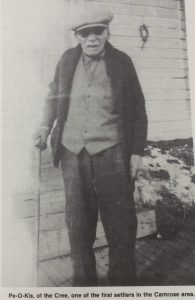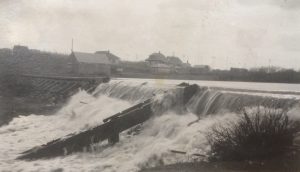The Landscape Leading up to a Lake
A Moment of Stillness…
Before settlements bloomed across the prairie, I wandered freely across the land. Dancing and caressing the curves sculpted by the glaciers before me, I ever follow the gradual trail downwards towards the centre of the earth. My craft is both more rapid and more subtle than the behemoth ice queens of old, banks and valleys shifting little by little with each season, each rapid, each ribbon I flick and twirl. In one area, the path lay blocked by earth and stone, so I sat and spread and paused to feel the rhythm of the earth, to sink into the depths and savour the feeling of settling silt. Sitting still, I could pay more attention to what lay beyond my narrow bed, and I spread out to explore beyond my banks. The movement never ceases to call me further, forward, down, along. My pause is momentary in the span of my journey. I swell beyond the reaches I can explore, and the momentum calls once more as I topple over the dam, the break, the pause, and tumble down again into my dance towards the unknown.
Memories from the Distant Past…

Caption reads “Pe-O-Kis, of the Cree, one of the first settlers in the Camrose area.
The myths we tell about ourselves help shape who we become. This is especially true for the places we define and develop in cultural memory.
Recognized as one of the most well-known first residents of the Camrose area, Pe-O-Kis, of the Cree First Nation, born in 1872 “out on the prairie”, lived just beyond his 125th birthday in 1936. In A Light into the Past: A History of Camrose, a history book published in 1980 by the Camrose Historical Society, the author writes that Pe-O-Kis “left as a legacy many stories which, unfortunately, due to their length cannot be included in this brief historical outline.” One story surfaced from the small book Early History of Camrose Alberta and District published in 1947. This source, which refers to Pe-O-Kis as Métis, notes that his son, Louis interpreted the story which his father told. It is possible Pe-O-Kis fluently spoke his native tongue and possibly did not know English, and that his son was bilingual. The narrative Pe-O-Kis shares which is included in the 1947 History is one of the devastating impacts of the Smallpox Epidemic. A group of thirteen in the middle of summer roamed the prairie seeking horses. The ‘raiders’ came upon a camp of ‘tepees’ which appeared deserted and waited for a couple days for the inhabitants to return. When they did not, the group searched the camp and found the inhabitants dead. Pe-O-Kis continues that the group took some blankets with them, only realizing the camp died of smallpox when one of their own became ill. They abandoned the blankets, and stayed away from their home camp. Only Pe-O-Kis and one other survived out of the original thirteen. The narrative ends with a description of other groups and camps which suffered losses from this event.
Powerful as it is that Pe-O-Kis’ photo and brief recognition remains in these historical accounts, we must only speculate at the impact this elder had on the fledgling community which has become Camrose. First Nations peoples undeniably hold the most ancient history of this area, which has grown on Treaty 6 territory. Museums, however, often do not value the oral traditions as strongly as the written and tangible. Similarly, much of the history of Mirror Lake is lost to the echoes of time, unwritten, unrecorded. Stories we may never hear that only the landscape knows.
A Lake Born to Fuel the Community…
Listen to Jeremy Enarson, City of Camrose Director of Engineering Services, speak on the founding origins of Mirror Lake.

Dam in Camrose, 1913. The “fish ladder” is propped up against the dam.

Camrose, 1930. The Dam running over. You can still see the “fish ladder” propped against the dam.
The Canadian Pacific Railway built the original dam which created Mirror Lake in the early 1900s. This dam, located across what is now the pedestrian bridge, created the farthest west basin of Mirror Lake from the flow of Stoney Creek.
Along this dam, one would sometimes see a small ladder propped into the water. This was known as the fish ladder from which community members would fish. Mirror Lake is no longer stocked with fish, and no fish remain in the lake. It remained in place, or different structures with the same function, for at least 20 years, and likely much longer. These images compare the fish ladder between 1913 and 1930.
You can listen to Jeremy Enarson speak on community memory regarding the clarity of the water in the lake.
Nostalgia…
The past can do funny things, or rather, we can do funny things with the past. Thinking about the clarity of the lake, and dreaming about the possibility of swimming in it again, and we can be transported to all sorts of places and times. Emotions can flare, imaginations can fly, but the lake itself seems to just sit there, a use-and-discard aesthetic novelty. Does knowing about the lake’s past change my imagination of its future? And if it does change, does it make it better? Or does it make it worse? Nostalgia’s like a poison, but reconciliation can heal. The past is not what happened, but how we think about it today. Is the foundation rotting beneath the surface? Or are we preparing it to be built on? How do you tell the difference? The lake is telling a story, but ultimately we are the ones that write it. Mirror Lake is a foundation, but we are the ones that build on it.
The Story Continues…
In the 1930s, the dam was rebuilt further south, along the side of where the current dam exists. When this occurred, the homes in the areas which became the west and southern basins were demolished. Their foundations, however, were left to the flood waters of the new dam. Research has not uncovered whether these were ever removed.
The year 1974 saw the dam overflow. At this time, the city of Camrose completely rebuilt the dam in its current location, moving it from the side, to more fully span the south end of the southernmost basin. From this point on, the City of Camrose has kept documents on the maintenance and upkeep of the lake, as well as propositions for future endeavours.
Sources cited on this page:
Camrose and District Centennial Museum, Accession 1977.3.27, image (Dam with fish ladder, 1913).
Camrose and District Centennial Museum, Accession 2016.82.255, image (Dam running over with fish ladder, 1930).
Early History of Camrose Alberta and District. Publisher Unknown. 1947.
Jeremy Enarson. Interview by Gwendolyn Bracken and Curtis Rempel. 27 February 2018. COPLAC Digital Nature Writing Project. Camrose, Alberta. Personal Collection.
A Light into the Past: A History of Camrose 1905-1980. Edited by JR Stan Hambly. Camrose Historical Society, 1980.